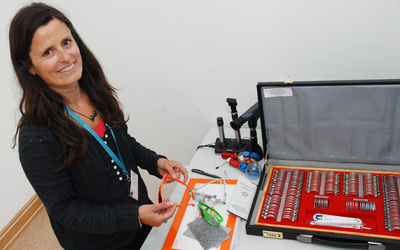- OT
- Life in practice
- Practitioner stories
- Thinking inclusively
Practice team guide
Thinking inclusively
Experts share their tips on how to ensure that every patient who walks through the door of an optical practice feels welcome

22 June 2021
Every optical practice sees patients who are apprehensive about attending a sight test.
They may be worried about what the results of their examination will reveal or be concerned about physical closeness during the test.
For some patients, the optical practice environment may be particularly daunting. For example, a child attending their first sight test is asked to perform strange tasks in an unfamiliar environment by someone they do not know.
Other patients may need certain measures in place to access the sight test equally. A patient with sight loss may need help navigating to the consulting room while a patient with hearing loss may appreciate a room without background noise.
OT talks with a range of experts for their guidance on how every member of the practice team can ensure that every patient who walks through the door of an optical practice feels welcome.
Learning disabilities and autism
Optometrist and SeeAbility head of eye health, Lisa Donaldson, shared that ensuring the best possible eye care for people with learning disabilities and autism starts with the booking of the appointment.

Donaldson suggested that practice staff could provide the patient with SeeAbility’s Telling the optometrist about me form (see ‘Useful resources’) and encourage them to complete it.
The patient could be given the option of visiting the practice before the sight test to become familiar and comfortable with the environment and practice team before their actual appointment.
“This will help both the optometrist and dispensing optician to prepare in advance and will also help the practice team to understand any anxieties,” Donaldson said.
Practice staff can find out how the patient likes to communicate and how their disabilities affect them – including if they are particularly sensitive to touch, lights and sounds.
Donaldson highlighted that practice staff should make sure the patient knows they can attend with their relative or carer.
“It’s extremely important though, that when communicating, you always talk directly to the person rather than their carer,” she added.
Donaldson recommends that patients are provided with a written as well as verbal report following their appointment.
Sight loss
Daniel Williams, founder of Visualise Training and Consultancy, highlighted that there are simple adjustments that can improve the experiences of patients with sight loss in practice.
“With some basic training for staff in understanding and attitudes, together with some small improvements in the layout and access to buildings, the apprehension associated with attending a clinical appointment could fade away,” he said.
Williams, who is registered blind, highlighted the importance of good lighting in practice.
He observed that many people with limited vision are able to navigate even the most complex buildings if their way is clearly lit.
With a simple personal greeting, thoughtful directions and the offer to act as guide, most of us will be fine
He added that the key to good lighting is continuity rather than patchy lighting that varies between areas.
“If you don’t experience low vision yourself, just think back to when you’ve been driving in bright, shifting sunlight. One moment everything’s in silhouette, the next it’s dazzlingly bright like a spotlight is beaming down on the road. Suddenly, you’re a danger to yourself and everyone in your path,” he said.
In optical practice waiting rooms, it is helpful to have chairs that stand out from their surroundings and are a different colour to the wall.
Glass surfaces in optical practices can also pose challenges for a patient with low vision.

Communication is also a key aspect of making a patient with sight loss feel comfortable in optical practice, Williams highlighted.
It can be confusing for a low vision patient to have a generic welcome followed by an instruction to sit ‘over there’ or ‘follow me.’
“You can’t see a ‘me’ to follow,” Williams explained.
“It all gets a bit perplexing as you stand there and scratch your head. Yet with a simple personal greeting, thoughtful directions and the offer to act as guide, most of us will be fine,” he said.
Small details like sending appointment letters to low vision patients in larger than average typeface or offering text and email options can be helpful.
Williams emphasised the importance of making patients aware of support services if they receive a diagnosis that could result in sight loss. Leaflets flagging available support services could be kept in the practice waiting area.
Sight loss: Dan’s top tips
- Make patients aware of support services if they are diagnosed with a sight-threatening condition
- Offer a personal greeting, give thoughtful directions and offer to act as a guide
- Ensure lighting is adequate and consistent in the practice.
Hearing loss
Optometrist and director of professional services at Leightons Opticians and Hearing Care, Andrew Bridges, highlighted that it is important to understand the hearing needs of patients.
During the pandemic, communication challenges for those with hearing loss have been exacerbated by face masks which reduce the ability to lip read and see other facial expressions or cues.

He added that reduced visual acuity in patients should be a flag to consider hearing loss.
“Each line of reduced best visual acuity increases the risk of a hearing impairment in adults by 18%,” he said.
Turning to steps that can improve a patient’s experience in practice, Bridges recommended facing patients to gain their attention.
A patient with hearing loss may be more comfortable being seen in a quiet area of the practice away from background noise, echos, music and other distractions, he shared.
Practice staff should speak clearly when communicating with the patient – without shouting or over-exaggerating their lip movements.
Bridges recommends avoiding covering your face when speaking – having a clear face mask on hand may be useful.
If known, practice staff can speak from the side that a patient hears best from.
Bridges also advises practices to draw on support services where appropriate, such as sign language interpreters, or speech to text apps, including Live Transcribe.
It is important to consider the experience of patients with hearing loss when their spectacles are removed for focimetry and when illumination in a room is reduced – this will limit their hearing as well as their vision.
Hearing loss: Andrew’s top tips
- Speak clearly but do not shout or over-exaggerate lip movements
- Have a transparent face mask available
- Be mindful of background noise
- Use interpreters or technological solutions to aid communication where appropriate.
Children
Optometrist Simon Berry specialises in seeing children and patients with learning disabilities at his Durham practice.
Berry qualified his guidance on offering eye care to children by noting that every professional has their own way of engaging a child during a sight test.
“Trying to comment on a correct way of doing it can seem a bit condescending,” he said.
However, in terms of his own approach to practice design, Berry highlighted that practice environments are often designed with an adult’s point of view in mind.
“Children will only feel comfortable in spaces that they can relate to and engage with. And there are ways of making our practice environments comfortable, calming and inclusive,” he said.
Colourful bright spaces may work well for a baby, while a toddler may appreciate toys and books that can be easily cleaned, and somewhere to charge their phone may be appreciated by a teenager.
There are ways of making our practice environments comfortable, calming and inclusive
For older children, having a children’s area away from adult spaces can be valuable, Berry shared.
“It means that children are included and have their own space to gravitate towards,” he said.
“At my own practice we also have a few other little tricks. We have a bubble wall in the testing room that helps create that calming environment, and a children’s rucksack of toys that we give to young children,” Berry shared.
He has addressed difficulties getting children to turn their gaze in a certain direction with the Visual Fixation System, manufactured by Optimec.
The device uses a mobile phone as a target giving the optometrist the ability to engage the patient’s attention by playing a video during the sight test.


Comments (0)
You must be logged in to join the discussion. Log in